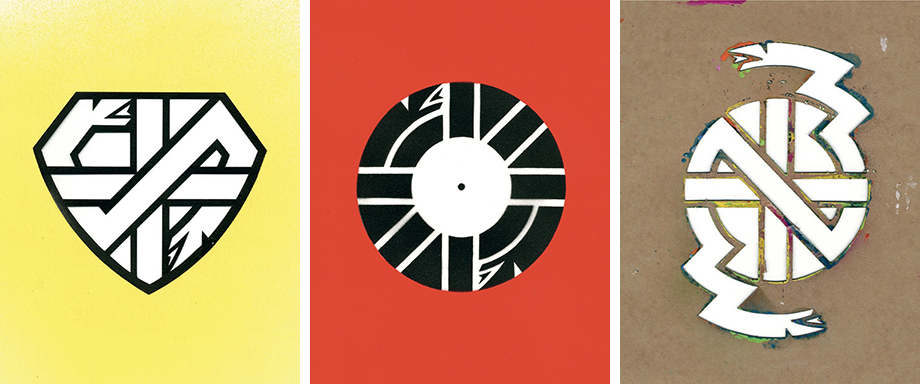
October 31, 2019
Dave King (RIP)

Last January I thought I had received an email from a ghost. The sender was David King, who I naturally mistook for the UK graphic designer, magazine and book editor, and collector/scholar who, the New York Times wrote when he died in 2016 at 73, had amassed “a trove of Soviet Political art” that was donated to the Tate. I was ruefully unaware of the actual sender, the other UK-born, San Francisco-based graphic designer, David (Dave) King, who had designed the enduring emblem for the punk band Crass in 1977. I was also ignorant of this emblem.
Dave King’s email was a request for me to write a foreword for a book of his stencil imagery, David King Stencils: Past, Present and Crass (Gingko Press) that included the mark, variations thereof and other powerful street and political art icons. I was a bit unnerved: The David King I knew was well known for, among other activist work, his anti-aparthied and anti-fascist posters in England, while the Dave King who I did not know created anti-war, anti-rascist and anti-capitalist marks and posters in the United States, including a brilliant Mickey Mouse-as-hammer-and-sickle. To add to the coincidence, I was just finishing my book The Swastika and Other Hate Symbols and Dave King’s stencil work fit into what I was writing about — his work being an inoculation against the white extremist virus.

I graciously accepted his invitation. He graciously accepted my ignorance of him, Crass and punk history in general. He requested “that I focus on the power of the symbol;” “Perhaps downplay the band itself, to the extent that it’s possible to separate the band from its symbol; “include reference to other content of the book in terms of design approach and use of the stencil medium,” which was fortuitous since I had just finished a book on stencil type, although he made clear “In my mind the book is a lot about the stencil technique itself as well as the subject matter. Hence the title. The technique greatly affects how a piece is designed. We’ve included the stencils themselves and shown them before they’re used and after, covered in spray paint. There is a lush tactility to the layered paint that is its own appealing aesthetic. At least to me! The Crass Symbol is the hook but not the whole story.” So I wrote a foreword that, although he edited it down by over 200 words (for the better), made me proud. I was anxious to see the book.
About the Crass emblem I wrote, in part: The logo for the punk band Crass (1977–1984), designed by Dave King…is explosive and memorable. He equates his design with the ubiquitous Campaign for Nuclear Disarmament (CND) logo, best known as the “peace sign,” inspired by Bertrand Russell and designed in the UK by Gerald Holtom in 1958. The peace sign echoes an early Christian-era mark called the crow’s foot and it became the primary ban-the-bomb protest symbol in the early 1960s. (Another origin story posits that the CND symbol is the combination of two semaphore signs for N and D, implying the crow’s foot was a coincidence.)

“The symbol later evolved into the emblem for the emergent anti-Vietnam War peace movement and has retained its vitality for over 60 years. The Crass logo has a similar trajectory. It is a “peace symbol for punks,” King told me. “In fact I discovered years later that the peace symbol nestles within the Crass one,” he said. In 1977 King originally designed the symbol for an agitprop pamphlet railing against the British church and state titled “Christ’s Reality Asylum.” Fifty copies were run off on a Gestetner copier. The type and logo were spray-painted on a gray cardboard cover using hand-cut stencils. “The design was specifically wrought to be stenciled,” he explained, adding, “what lends it resonance I think is having a double-headed snake and the strong, negating diagonal at the heart.”

“Later the same year the pamphlet’s author, Penny Rimbaud, co-founded Crass and applied the mark as the band’s symbol. “It fit neatly and dramatically on the bass drum,” King said. King’s design deliberately takes chances with double-edged symbolic elements. An alternative version of the mythic ouroboros, a snake eating its own tail, is rendered as two legs of a suncross, intertwined with a symmetrical (Celtic or Christian) cross also commonly found in ultra-right-wing emblems. In the war of ideological signs and symbols, this can be a confusing signal—but the result, like a vaccination, uses some of the disease to create immunity. This is why King’s logo, like the peace sign, has achieved the transcendent status he very much wanted. King designed the Crass logo to attack the very images it co-opts. The band advocated anti-fascist, anti-capitalist, anti-establishment, anarchic action, and King’s work in general, through prodigious stenciling and spray-painting, is an antidote to the symbolic bombardment from the middle and far-right.”

Last Tuesday, I received word from Gingko that Dave King passed away from cancer at age 71, two years younger than David King. I was told he had a chance to see the finished book before he died. Sadly, I never got a chance to meet him but at least I learned about him and the role he played. (An insightful obituary can be found here.)
David King Stencils: Past, Present and Crass is a revelation to me and testament to a significant figure in design history. Thank you David for inviting me to be part of your story.
Observed
View all
Observed
By Steven Heller
Related Posts

Civic Life
Bert de Muynck|Essays
Walkie talkie: An architect-turned-tour guide on designing presence in Lisbon

Business
Courtney L. McCluney, PhD|Essays
Rest as reparations: reimagining how we invest in Black women entrepreneurs

Design Impact
Seher Anand|Essays
Food branding without borders: chai, culture, and the politics of packaging

Graphic Design
Sarah Gephart|Essays
A new alphabet for a shared lived experience
Related Posts

Civic Life
Bert de Muynck|Essays
Walkie talkie: An architect-turned-tour guide on designing presence in Lisbon

Business
Courtney L. McCluney, PhD|Essays
Rest as reparations: reimagining how we invest in Black women entrepreneurs

Design Impact
Seher Anand|Essays
Food branding without borders: chai, culture, and the politics of packaging

Graphic Design
Sarah Gephart|Essays

 Steven Heller is the co-chair (with Lita Talarico) of the School of Visual Arts MFA Design / Designer as Author + Entrepreneur program and the SVA Masters Workshop in Rome. He writes the Visuals column for the New York Times Book Review,
Steven Heller is the co-chair (with Lita Talarico) of the School of Visual Arts MFA Design / Designer as Author + Entrepreneur program and the SVA Masters Workshop in Rome. He writes the Visuals column for the New York Times Book Review,